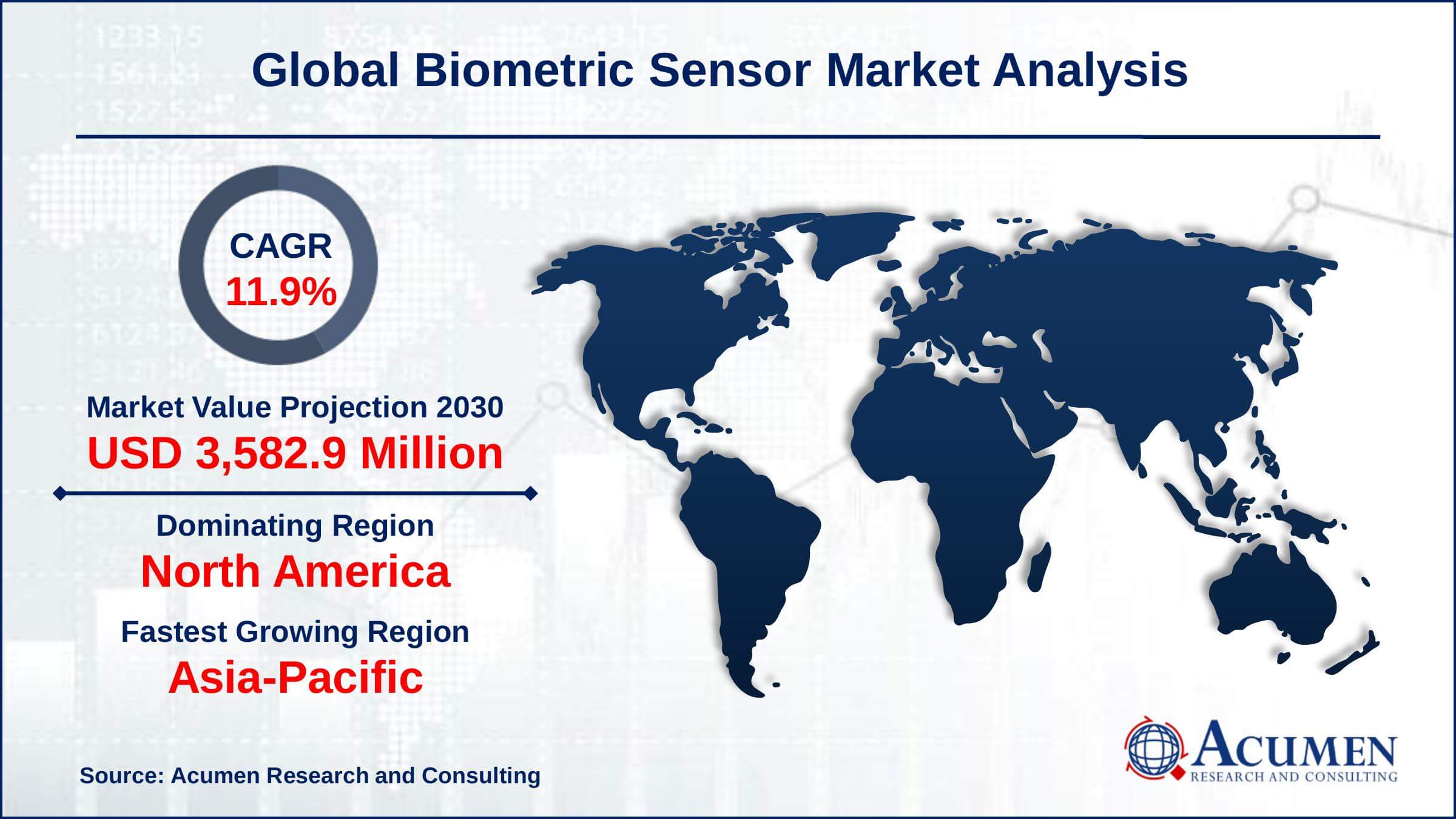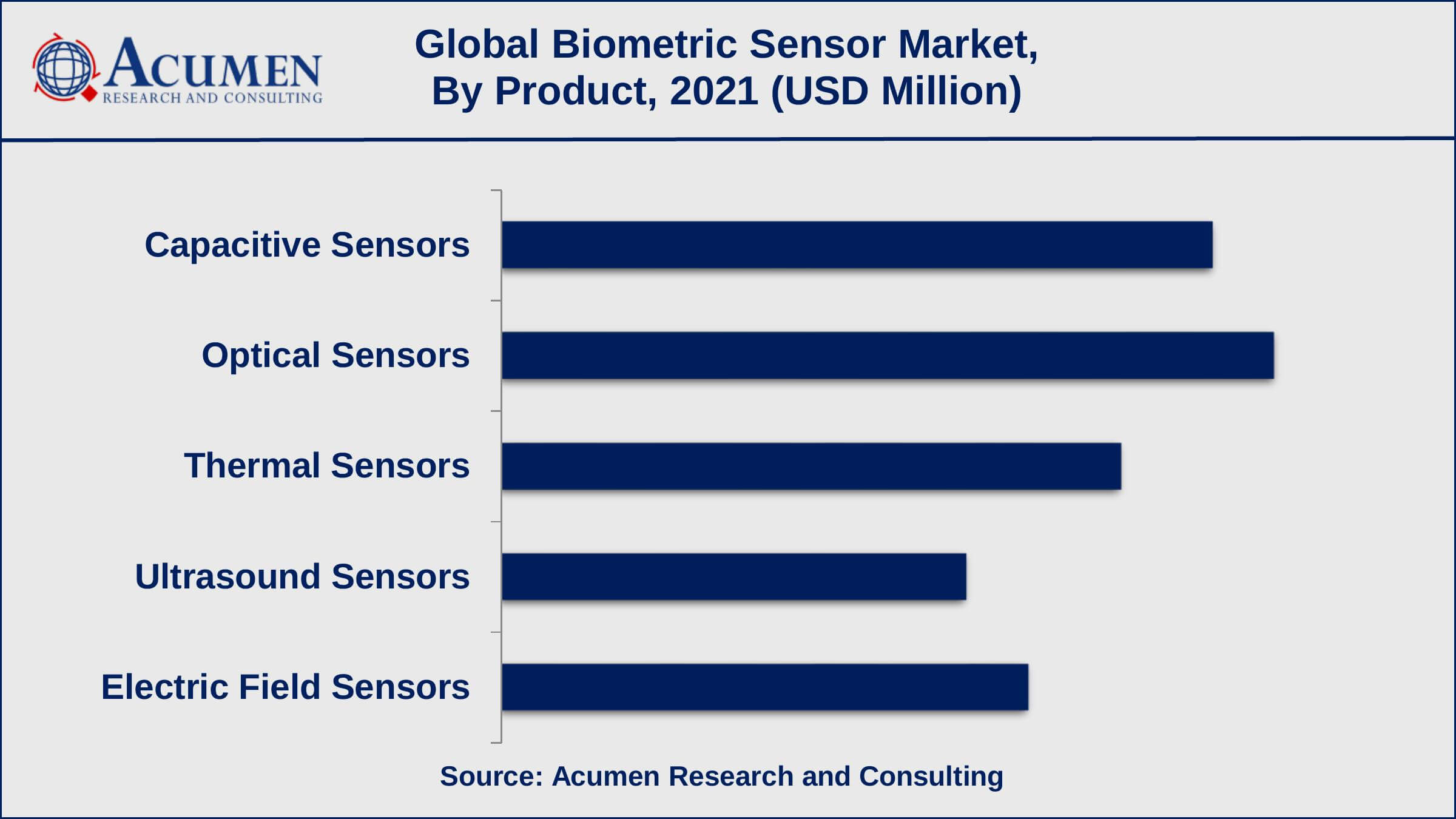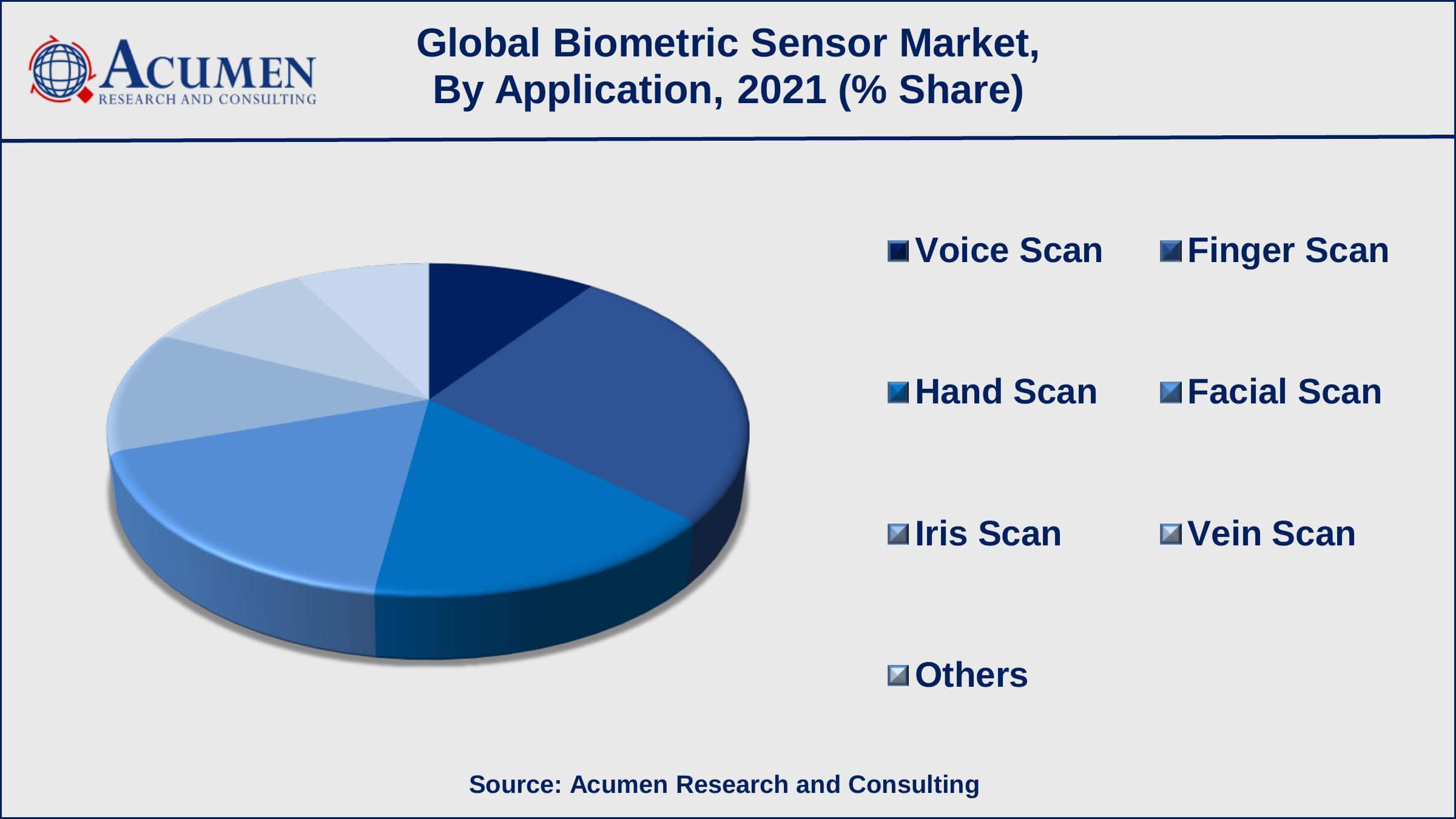Biometric Sensors Market Size - Global Industry, Share, Analysis, Trends and Forecast 2022 - 2030
Published :
Report ID:
Pages :
Format :
Biometric Sensors Market Size - Global Industry, Share, Analysis, Trends and Forecast 2022 - 2030
Report Coverage
- Industry Dynamics
- Market Size and Forecast Data
- Segment Analysis
- Competitive Landscape
- Regional Analysis with a Niche Focus on Country-Level Data
- High Level Analysis - Porter's, PESTEL, Value Chain, etc.
- Company Profiles of Key Players
- Option to Customize the Report As Per Your Specific Need
Request Sample Report
The Global Biometric Sensors Market Size gathered USD 1,319.5 Million in 2021 and is set to garner a market size of USD 3,582.9 Million by 2030 growing at a CAGR of 11.9% from 2022 to 2030.
A biometric sensor is a device that measures biometric data such as fingerprints, iris scans, or facial recognition. Fingerprints, faces, iris, voice, and body odor are examples of biometric sensors that measure and analyze an individual's physical and behavioral characteristics. These characteristics can be used for identification and authentication because they are unique to each individual and difficult to replicate. Biometric data protection, privacy, and security concerns have recently gained traction, thanks to the development of new regulations and standards such as GDPR, and businesses are implementing new methods to keep biometric data secure and private.

Biometric Sensors Market Report Statistics
- Global biometric sensors market revenue is estimated to reach USD 3,582.9 Million by 2030 with a CAGR of 11.9% from 2022 to 2030
- North America biometric sensors market value gathered more than USD 435 million in 2021
- As per recent stats, over 75% of Americans have used biometric technology for various purposes
- Asia-Pacific biometric sensors market growth will record a CAGR of more than 12% from 2022 to 2030
- Based on product, the optical sensors sub-segment achieved over 25% of share in 2021
- Among application, the finger scan sub-segment collected revenue of around US$ 356 million in 2021
- A current study says face authentication is already used by 38% of people to access their mobile banking app
- The growing integration of AI and ML in biometrics is a popular biometric sensors market trend that drives the industry demand

Global Biometric Sensors Market Dynamics
Market Drivers
- Growing demand for security
- Increase in number of government initiatives
- Rising number of frauds and illegal activities
Market Restraints
- High cost of implementation
- Privacy concerns such as data hacks
Market Opportunities
- Increasing adoption of smartphones
- Rapid implementation of AI and machine learning technologies
Biometric Sensors Market Report Coverage
| Market | Biometric Sensors Market |
| Biometric Sensors Market Size 2021 | USD 1,319.5 Million |
| Biometric Sensors Market Forecast 2030 | USD 3,582.9 Million |
| Biometric Sensors Market CAGR During 2022 - 2030 | 11.9% |
| Biometric Sensors Market Analysis Period | 2018 - 2030 |
| Biometric Sensors Market Base Year | 2021 |
| Biometric Sensors Market Forecast Data | 2022 - 2030 |
| Segments Covered | By Product, By Application, By End-Use, And By Geography |
| Regional Scope | North America, Europe, Asia Pacific, Latin America, and Middle East & Africa |
| Key Companies Profiled | CROSSMATCH Technologies Inc, Fujitsu, Fulcrum Biometrics, IDEX ASA, Infineon Technologies, Precise Biometrics AB, NEC Corporation, SAFRAN SA, Thales Group, and ZKTECO Inc. |
| Report Coverage |
Market Trends, Drivers, Restraints, Competitive Analysis, Player Profiling, Covid-19 Analysis, Regulation Analysis |
Biometric Sensors Market Growth Factors
The rising demand for security is a major factor propelling the global biometric sensor market. Because of the increasing number of data breaches and cyberattacks, there is a greater need for secure authentication methods, making biometric sensors an appealing option. A growing number of government initiatives are fueling the growth of the biometric sensors industry. Governments around the world are implementing biometric technology in a variety of applications, including border security, national ID programmes, and criminal identification, fueling market growth.
Increasing adoption of biometric sensors in the financial and healthcare sectors is expected to create significant opportunities for the market between 2022 and 2030. Biometric sensor technology, for example, is increasingly being used in the financial sector for secure transactions, as well as in the healthcare sector for patient identification and access to medical records. Furthermore, rising smartphone and other mobile device adoption would provide significant traction for market growth. Biometric sensors, such as fingerprint and facial recognition, are increasingly being integrated into smartphones and other mobile devices, resulting in increased technology adoption. Furthermore, the advancement of AI and machine learning technology is assisting the biometric sensor market to expand in various industry verticals due to their efficiency. The integration of AI and machine learning technology with biometric sensor technology is also propelling market growth, as it enables more accurate and efficient identification and authentication.
However, the biosensor market is constrained by factors such as concerns about privacy and data theft, high implementation costs, technical limitations, and a lack of standardization. The use of biometric sensor technology, for example, raises privacy concerns because it involves the collection, storage, and use of personal information. These concerns have resulted in the creation of new regulations and standards to protect personal data, but they can also act as a barrier to adoption. Furthermore, biometric sensor technology can be costly to implement, especially for large-scale applications, which can be a barrier for some organizations.
Biometric Sensors Market Segmentation
The worldwide biometric sensors market is categorized based on product, application, end-use, and geography.
Biometric Sensors Market By Product
- Capacitive Sensors
- Electric Field Sensors
- Optical Sensors
- Thermal Sensors
- Ultrasound Sensors

According to our biometric sensors industry analysis, the optical sensors sub-segment is accounted to have a significant market share in 2021. Optical biometric sensors are a type of biometric sensor that captures and analyses biometric data using light-based technology. The market for optical biometric sensors is expanding as these sensors are increasingly used in applications such as security and surveillance, access control, and mobile devices. Technology advancements have made optical biometric sensors more accurate, reliable, and simple to use, making them more appealing to a variety of industries.
Biometric Sensors Market By Application
- Finger Scan
- Facial Scan
- Hand Scan
- Iris Scan
- Vein Scan
- Voice Scan
- Others

Based on application, the finger scan sub-segment generated the most revenue in 2021 and is expected to continue to do so in the coming years. One of the most mature and widely used biometric technologies is fingerprint recognition technology, also known as fingerprint scanning or fingerprint biometrics. The market for finger scan biometric sensors is expanding as these sensors are increasingly used in applications such as security and surveillance, access control, and mobile devices. Advances in technology have made fingerprint recognition more accurate, reliable, and simple to use, making it more appealing for use in a variety of industries.
Biometric Sensors Market By End-Use
- Automotive
- Banking and Financial Sector
- Commercial Center
- Consumer Electronics
- Educational Hubs
- Hospital
- Research Lab
- Others
According to the biometric sensors market forecast, the commercial center sub-segment is expected to witness a significant market share between 2022 and 2030. In recent years, there has been an increase in the demand for biometric sensors in commercial settings such as offices, shopping malls, and retail stores. One of the most common applications for biometric sensors in commercial centers is access control, where they can be used to limit authorized personnel's access to specific areas of the building. Biometric sensors can also be used to track employee time and attendance, reducing administrative tasks and providing more accurate and reliable data.
Biometric Sensors Market Regional Outlook
North America
- U.S.
- Canada
Europe
- U.K.
- Germany
- France
- Spain
- Rest of Europe
Asia-Pacific
- India
- Japan
- China
- Australia
- South Korea
- Rest of Asia-Pacific
Latin America
- Brazil
- Mexico
- Rest of Latin America
The Middle East & Africa
- South Africa
- GCC Countries
- Rest of the Middle East & Africa (ME&A)
Biometric Sensors Market Regional Analysis
North America generated the maximum market share and is expected to do so in the coming years due to the presence of key players and the high adoption of biometric technology in various application areas such as government, financial, and healthcare. In addition, Europe is also expected to have a significant market share due to the adoption of biometric technology in various industries and the presence of stringent regulations and data protection policies. On the other hand, Asia-Pacific region is anticipated to attain fastest growth rate during the forecasted years from 2022 to 2030. Growing commercial building projects, rising smartphone and smartwatch adoption, and rising private and public investments in hospital and research lab development are some of the factors driving the APAC biometric sensors market.
Biometric Sensors Market Players
Some of the leading biometric sensors companies include CROSSMATCH Technologies Inc, Fujitsu, Infineon Technologies, Fulcrum Biometrics, IDEX ASA, Precise Biometrics AB, NEC Corporation, SAFRAN SA, Thales Group, and ZKTECO Inc.
Frequently Asked Questions
What was the market size of the global biometric sensors in 2021?
The market size of biometric sensors was USD 1,319.5 Million in 2021.
What is the CAGR of the global biometric sensors market during forecast period of 2022 to 2030?
The CAGR of biometric sensors market is 11.9% during the analysis period of 2022 to 2030.
Which are the key players operating in the market?
The key players operating in the global biometric sensors market are CROSSMATCH Technologies Inc, Fujitsu, Fulcrum Biometrics, IDEX ASA, Infineon Technologies, Precise Biometrics AB, NEC Corporation, SAFRAN SA, Thales Group, and ZKTECO Inc.
Which region held the dominating position in the global biometric sensors market?
North America held the dominating position in biometric sensors market during the analysis period of 2022 to 2030.
Which region registered the fastest growing CAGR for the forecast period of 2022 to 2030?
Asia-Pacific region exhibited fastest growing CAGR for biometric sensors market during the analysis period of 2022 to 2030.
What are the current trends and dynamics in the global biometric sensors market?
The current trends and dynamics in the biometric sensors industry include growing demand for security, increase in number of government initiatives, and rising number of frauds and illegal activities.
Which product type held the maximum share in 2021?
The optical sensors product type held the maximum share of the biometric sensors market.



